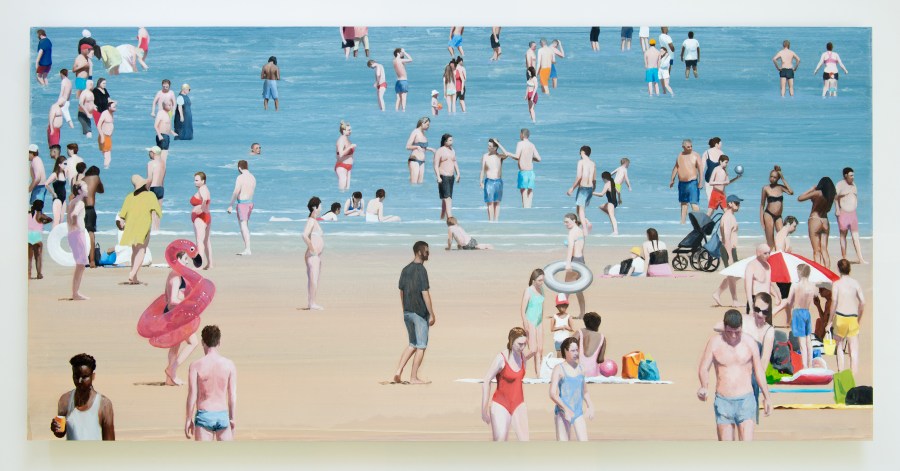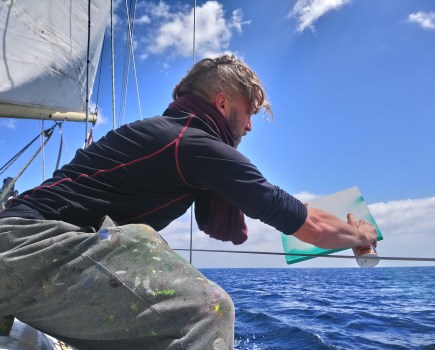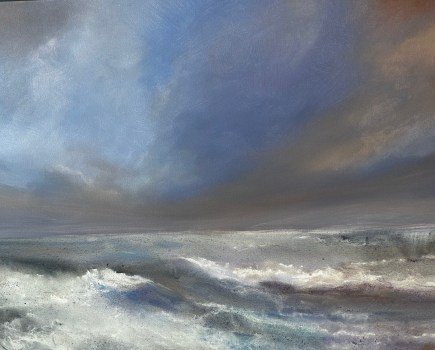Artist David Edmond perfectly captures beach life in his latest series of works. He tells CAROL BURNS how the Kent coastline has inspired him.
The coastline seems a natural place for artists. The light, the changing weather, the endless possibilities of seascapes and landscapes, not to mention the contrast between busy bustling beaches and a quiet contemplative expanse of empty sand.
But ironically, the beach can offer little visual inspiration for artists. It can lack landmarks, and colours are often limited to the blues and grey of the sea and sky, and the yellow ochre of golden sands. Under the paintbrush of a lesser artist, beachscapes can be unfocused and underwhelming.
But artist David Edmond has taken up the challenge. The beach has become the latest vista to capture his artistic eye with the result of a series of stunning beachscapes that capture the pure joy of beach life in all its many forms.
David brings colour to his work through vibrant parasols and the endless beach accoutrements that make up the perfect seaside day out. And instead of buildings or rock formations, the detailed figures in his work become landmarks.
The subjects of David’s figurative paintings are varied and generally developed from the artist’s photographs during his own days out at the coast. And these works are inspired by the Kent coastline (by way of Coney Island in New York). He doesn’t identify the place in his titles, and the more abstract backgrounds make it impossible to identify, offering up a sense of the universal: it could be any beach anywhere and by extension those people enjoying themselves could be you.
Despite the populous views of many of his works, often featuring many people at play, they remain, at heart, peaceful. His subjects are captured in a state of contentment.
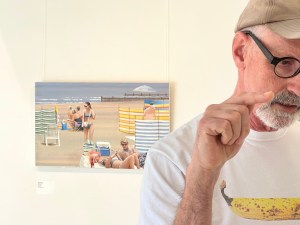
Meet more coastal artists here.
Edmond’s body of work is evidence of just how varied our experiences of the beach can be from joyful to thoughtful, loud and boisterous to quiet and contemplative. And his work is the closest many of us can get to the perfect day out on the beach, which adds a sense of yearning, that the beach-loving viewer will undoubtedly bring to the work.
David came to painting in his fifties but has been creative all of his life, originally studying furniture design and printed textile design at the Royal College of Art London. He began painting in 2009 and he has quickly gained fans with gallery shows at the Mall Gallery and prestigious Royal Academy Summer shows and representation through Cavaliero Finn.
David trained as a textile designer at the Royal College of Design and that was the career he chose. Although always a painter at heart, he felt he had nothing to say through art at that time and only began painting professionally ten years ago.
“I’m 68 now and I’m really glad I got around to this!” he says. Perhaps his age is what makes him so prolific – a series typically features up to 50 paintings.
“I think it is the human condition that interests me,” he says. “Our relationship with others, that’s what I want to reflect in the work.”
It’s a fascinating insight: few places other than the beach offer such intimate activities in such disparate groups, so close together. Eating, sleeping, changing clothes (under a towel) and playing.
His beach series came out of visits to Margate, Broadstairs and Deal along the Kent coastline. David will typically take hundreds of photographs, often at random, and will review his cache when he gets back into his studio. Despite not working en plein air (outside), David will capture the light, the weather and conditions alongside his chosen view.
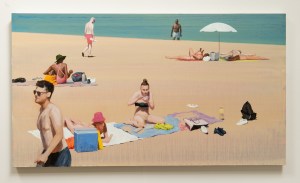
“For example, the beach in Margate faces north so you don’t get the glare,” he explains. Elsewhere figures will appear in silhouette. He is drawn to the interaction, quirks and eccentricities of humanity that take place within a beach setting.
David can also be found using other inspirations including a series of lake paintings depicting the landscapes of Maine in the United States.
The images are layered, there’s a rich sense of storytelling to his work. The figures are detailed but not photo-realistic. His more abstract backgrounds work as a foil to the figurative.
Overall the images are optimistic, there’s a sense of nostalgia but it’s more thoughtful Edward Hopper than turn-of-the-century stylised holiday posters.
Seemingly crowded beaches will have large unpopulated areas, allowing the eye to rest and consider the bigger picture.
The images appear to expand beyond his canvases, figures appear to walk in and out of the image as they enjoy their day at the beach. The paintings use portrait-shaped surfaces, instead of the more commonly used landscape to present a literal slice of beach life.
However you view them, you will feel the warmth, the pleasure and the relaxation that comes with time on the beach.
See more of david’s work at cavalierofinn.com/artists/45-david-edmond/

